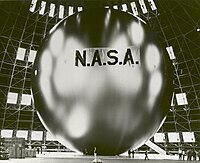Project Echo

Echo 1 sits fully inflated at a Navy hangar in Weeksville, North Carolina
|
|
| Operator | NASA |
|---|---|
| Harvard designation | 1960 Alpha 11 |
| COSPAR ID | 1960-009A |
| SATCAT № | 49 |
| Spacecraft properties | |
| Manufacturer | Bell Labs |
| Launch mass | 66 kg (146 lb) |
| Dimensions | 30.48 m (100.0 ft) diameter sphere when inflated |
| Start of mission | |
| Launch date | 09:39:43, August 12, 1960 |
| Rocket | Thor-Delta |
| Launch site | Cape Canaveral AFS SLC-17A |
| End of mission | |
| Decay date | May 24, 1968 |
| Orbital parameters | |
| Reference system | Geocentric |
| Eccentricity | 0.01002 |
| Perigee | 1,524 km (947 mi) |
| Apogee | 1,684 km (1,046 mi) |
| Inclination | 47.2° |
| Period | 118.3 min |

Echo 2 undergoing tensile stress test in a dirigible hangar at Weeksville, North Carolina
|
|
| Operator | NASA |
|---|---|
| COSPAR ID | 1964-004A |
| SATCAT № | 740 |
| Spacecraft properties | |
| Manufacturer | Bell Labs |
| Dimensions | 41 m (135 ft) diameter sphere when inflated |
| Start of mission | |
| Launch date | 13:59:04, January 25, 1964 |
| Rocket | Thor-Agena B |
| Launch site | Vandenberg AFB |
| End of mission | |
| Decay date | June 7, 1969 |
| Orbital parameters | |
| Reference system | Geocentric |
| Eccentricity | 0.01899 |
| Perigee | 1,029 km (639 mi) |
| Apogee | 1,316 km (818 mi) |
| Inclination | 81.5° |
| Period | 108.95 min |
Project Echo was the first passive communications satellite experiment. Each of the two American spacecraft, launched in 1960 and 1964, was a metalized balloon satellite acting as a passive reflector of microwave signals. Communication signals were bounced off them from one point on Earth to another.
NASA's Echo 1 satellite was built by Gilmore Schjeldahl's G.T. Schjeldahl Company in Northfield, Minnesota. The balloon satellite functioned as a reflector, not a transceiver, so after it was placed in a low Earth orbit a signal could be sent to it, reflected by its surface, and returned to Earth.
During ground inflation tests, 40,000 pounds (18,000 kg) of air was needed to fill the balloon, but while in orbit, several pounds of gas were all that was required to fill the sphere. At launch the balloon weighed 156.995 pounds (71.212 kg) which included 33.34 pounds (15.12 kg) of sublimating powders of two types. The first weighing 10 pounds (4.5 kg) with a very high vapor pressure, the second with a much lower vapor pressure. According to NASA, "To keep the sphere inflated in spite of meteorite punctures and skin permeability, a make-up gas system using evaporating liquid or crystals of a subliming solid were incorporated inside the satellite."
The first attempt to orbit an Echo satellite (also the maiden voyage of the Thor-Delta launch vehicle) miscarried when Echo 1 lifted from Cape Canaveral's LC-17A on the morning of May 13, 1960. The Thor performed properly, but during the coasting phase, the attitude control jets on the unproven Delta stage failed to ignite, sending the payload into the Atlantic Ocean instead of orbit. Echo 1A (commonly referred to as just Echo 1) was put successfully into a 944-to-1,048-mile (1,519 to 1,687 km) orbit by another Thor-Delta, and a microwave transmission from the Jet Propulsion Laboratory in Pasadena, California, was received at Bell Laboratories in Holmdel, New Jersey, on August 12, 1960.
...
Wikipedia
